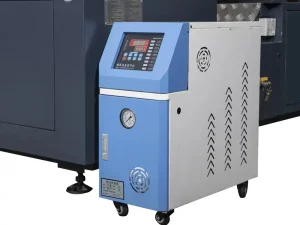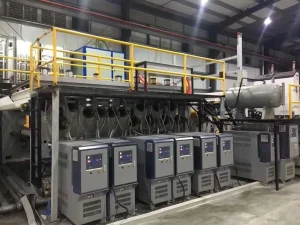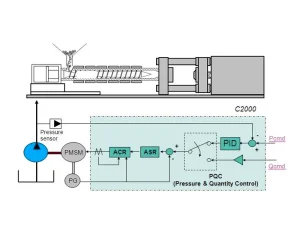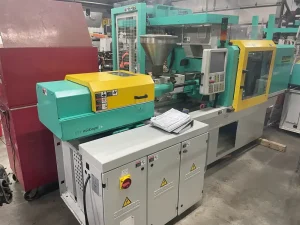Injection molding machines are not very simple. They consist of many different components. The role and functionality of each element vary from others. Among those, the temperature controller is an integral component. What is a Mold Temperature Controller, exactly? That’s a million-dollar question.
Remember, some advanced injection molding machines come with built-in controllers. The operator uses a separate temperature controller to maintain temperature in old-fashioned machines. Is temperature maintenance essential in injection molding machines? How do the MTCs control the temperatures? Let’s dive in and get answers to all these questions.
Overview of Mold Temperature Controller

It is a small device that uses fluid or water to control the temperature. Modern injection molding machines come with built-in mold temperature controllers. These controllers can increase or decrease the temperature depending on the needs.
Their role is critical to producing high-quality products. Let me explain how. The injection molding machine works by using molten rubber or plastics. This molten material goes into the molds. The temperature of this mold plays a critical role in the formation of the final products. The molten material solidifies in the molds.
Imagine if the mold temperature remains very high. The molten material won’t solidify, and you won’t get the product, right? Similarly, if the molds are too cold, they produce low-quality, cracked products. Both of these cases are not good for the manufacturers. In this case, the magic of mold temperature controllers comes into play.
The mold temperature controllers ensure the temperature that the mold needs. For example, the controller provides high heat during molten material injection. This helps the molten material fill in the mold quickly. After that, the controllers reduce the temperature. This low temperature allows the molten material to Spotify.
Quick Highlight: The mold temperature controllers are the heart of injection molding machines. Remember, a slight temperature deviation can cause warping and shrinkage of parts. So, these controllers keep the temperature at the desired level. So, manufacturers get high-quality products without any defects.
Components of Mold Temperature Controller

The mold temperature controllers consist of different parts. Each of those parts plays an integral role in maintaining the temperatures. Here is the list of those components:
- Fluid Reservoir
- Heating Element
- Pressure Gauges
- Temperature Sensors
- Cooling System Pump
- Valves to control fluid flow
As I said earlier, the MTCs consist of water and oil. These fluids are vital in increasing or decreasing the molds’ temperature. The pumps are inside the molds, which remain connected to the reservoir. The fluid goes through this pump and is inside the molds’ channels. The pressure gauges check the pressure of the liquid that flows through the pump.
The heating element heats the water that then goes into the pump to increase the temperature of the mold. Wondering how these controllers reduce the temperature? These devices are connected to additional chillers that give cold water. This cooled fluid goes into the pump to lower the temperature of the mold.
There is one more question. How do these controllers know when to adjust the temperature? For this purpose, these mold temperature controllers contain sensors. The real-time temperature data is displayed on the controllers’ screens. Some modern controllers have a feedback system to automate the process. However, operators can also manually adjust the temperature by seeing the screen’s data.
How Does Mold Temperature Controller Work in Injection Molding Machines?

Working with these MTCs is very straightforward. As you know, injection molding machines work with molten material. This material is then injected into the mold, solidifying it to make the products. The shape of this product is precisely similar to the shape of the mold. Is that clear?
These controllers pump hot water or oil into the mold channels during injection. Remember, molds have channels inside them. These hot fluids keep the temperature high by flowing in those channels. If the temperature decreases at this step, cracked products will result.
Once the injection is completed, the controllers reduce the temperature. This step pumps cooled fluid into the molds’ channels. This cool fluid absorbs heat, causing the mold’s temperature to decrease. At this reduced temperature, the molten material starts to solidify.
Once the material is solidified, it is time to eject it from the mold. Keep in mind that this solidified material has a shape similar to molds. The temperature should be adjusted to the required degrees. This ensures smooth ejection of the product from the mold. If the temperature is too low or high, it will cause issues in the ejection process.
During the working of MTCs, all the components work in harmony. From temperature sensors to heating elements, all play their roles. If one part starts to malfunction, the whole device will fail. If these controllers do not work correctly, you won’t be able to get high-quality products. It means that the entire production will collapse.
Types of Mold Temperature Controllers
The mold temperature controllers have two types. They vary in terms of the fluid that they use to increase or decrease the temperatures. Here are the names of those types:
- Water-based mold temperature controllers
- Oil-based mold temperature controllers
Water-based controllers pump water into the mold channels to control the temperature. However, these controllers suit lower range temperatures (90°C to 120°C). On the flip side, oil-based controllers use oil as a fluid. This oil flows into the channels of the molds.
What I like about these oil-based controllers is that they can work when the temperature is high. Sometimes, you must achieve a very high temperature during injection molding methods. These oil-based mold temperature controllers come in handy in such cases. They can work best in very high temperatures of around 150°C to 350°C.
Advantages of MTCs in Injection Molding Machines

The injection molding machine uses different materials, such as rubber and plastic. They help make products of different shapes. But all that material undergoes this injection molding process at different temperatures. For example,
- ABS (Acrylonitrile Butadiene Styrene) undergoes mold temperatures of 60°C and 80°C
- The nylon material requires a temperature above 100°C during the molding process
The same goes for all other materials as well. Each has its specific temperature requirement according to its strength. In such a case, mold temperature controllers come in handy. They help increase and decrease the mold temperatures for different materials.
Molten-filled in the mold requires a tight temperature range. Minor deviations would result in weaker products. Incorrect temperature can also cause warping, cracking, and sink marks on the products. However, the MTCs maintain the temperature at specific levels that the material requires. Let’s dive deep and discuss some more advantages.
1- Speed up the Production Process
The mold temperature controllers can increase and decrease the temperature in the mold. This adjustment comes in handy. When the molten material needs to solidify, the controller reduces the temperature. This reduces the cycle time and speeds up the production process. If the temperature remains high, the solidification process will take more time. This will ultimately affect the speed of the injection molding process.
2- Production Quality
As I said earlier, every material requires a specific temperature in the mold. If the temperature is too high or too low, it will cause quality issues. These include wrapping, cracking, and marking that weaken the final product. However, these molding temperature controllers help avoid such problems.
They adjust the temperature according to the process’s needs. At first, the temperature remains high for easy milling of the mold. The temperature is lowered after the mold is filled. This helps the molten material solidify. As a result, the final product remains safe from cracking and other issues. So, manufacturers get the final product with excellent quality.
3- Safety of Molds
Different rubber injection molding machines come with solid molds. These molds are generally made with solid material to withstand high temperatures. However, fluctuation in extreme temperatures can weaken these molds. Consistent temperature does not affect the integrity of these molds.
The MTCs keep the temperature within a specific range. With no sudden temperature changes, the molds stay safe from thermal impacts. The temperature controllers adjust the temperature smoothly, enhancing the molds’ lift. Remember, a sudden fluctuation in extreme temperature is never good.
Frequently Asked Questions
What is a mold temperature controller?
It is a small device that uses water or oil to adjust the molds’ temperature. MTCs are a kind of thermostat. They pump the fluid into the mold channels to do the job. This device has many components, such as sensors, fluid reservoirs, pressure gauges, etc.
What is the meaning of mold temperature?
It is the temperature of the mold cavity where molten material goes. Regulating this temperature is critical for producing high-quality products. The molding machine will not produce precise products if it is not regulated.
Is a mold temperature controller a must for injection molding machines?
Yes, all the injection molding machines use these controllers. It helps adjust the temperature during mold filling. It also aids in the solidification of the molten material. Some modern injection molds come with built-in controllers.
Conclusion
A mold temperature controller is standard in injection molding machines. Remember, the quality of the final product is highly related to the temperature. If the temperature remains irregular, you’ll see issues in the final product.
But keeping the temperature steady will give you high-quality products. It will avoid any wrapping issues. For maintaining temperature, the MTCs are available. Their usability is becoming more famous. This guide covers all things related to these MTCs. You’ll also learn their role in injection molding machines.

